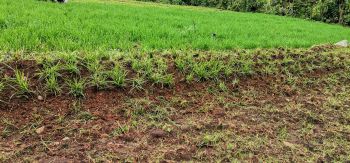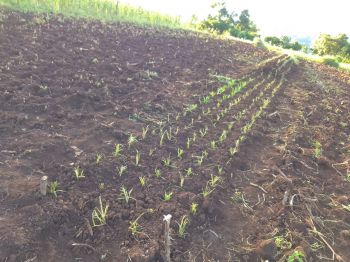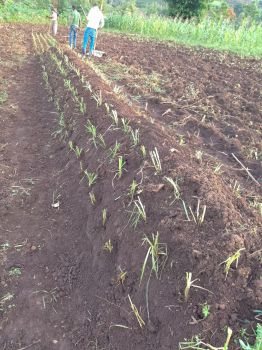News
Discover the latest news and events about our research project
Green Barriers: Grass Strips as Simple Nature-Based Solutions to Combat Land Degradation
Posted on behalf of: Dr Cynthia Olumba, Cranfield University - Work Package 1 - REAL NbS Project
Last updated: Tuesday, 18 November 2025

Desho grass strips on the REAL NbS project experimental field in Ethiopia

Desho grass strips on the experimental NbS field in Ethiopia: alone (above) and reinforced with soil bunds (below) to assess their combined effect on soil conservation.

With climate change driving unpredictable weather patterns and land degradation threatening soils across East Africa, farmers are facing growing challenges in maintaining crop productivity and sustaining their livelihoods. Protecting soil and water resources has never been more critical for the region’s future. Amid these challenges, a simple and low-cost nature-based solution (NbS), contour grass strips, is emerging as a promising approach to restoring degraded landscapes.
What Are Grass Strips?
Grass strips are rows of perennial, native grasses, usually planted on the contour along field edges, waterways or within crop fields. At first glance, they may look like ordinary patches of grass, but their environmental importance is far greater. Acting like natural barriers, grass strips slow down water flow, reduce soil erosion, and capture nutrients that would otherwise wash away downhill. They are especially valuable in areas with sloping terrain or fragile soils—conditions common across much of East Africa and other vulnerable regions.
How Grass Strips Help Control Land Degradation
Grass strips are not just about looking green; they bring multiple benefits to farming and land restoration:
- Conserving water: Instead of water rushing off the land surface, grass strips reduce the speed of flow. The roots of the grasses encourage infiltration, so the water soaks into the ground. This reduces flooding, recharges groundwater, and maintains healthier land in both wet and dry seasons.
- Stopping Soil Erosion: Surface flow can easily wash away topsoil, one of farmers’ most valuable resources. Grass strips reduce the speed and volume of water flow, so it doesn’t have the energy to cause soil erosion. The grass stems also help trap sediments, keeping fertile soil in place.
- Building Climate Resilience: In a changing climate, grass strips protect soil from extreme weather events. By keeping water in the soil, they reduce flood risks, maintain soil moisture in dry spells, and shield the land from wind erosion.
- Improving Soil Health: Over time, grass strips enrich soil with organic matter. The grass roots increase soil biological activity and improve soil structure, making the soil more resilient to climate stressors.
Beyond conservation benefits, grass strips attract a variety of insects, birds, and small animals, thereby boosting biodiversity and helping to restore balance to farming ecosystems. They also enhance the visual appeal of agricultural landscapes, fostering pride and stewardship among farmers and local communities.
Grass Strips in the REAL NBS Project
Planting grass strips is one of the NbS being tested within the REAL NbS project. The practice was co-selected during an inception workshop held in Ethiopia last year. With support from the project team, some farmers are now planting Desho grass strips on test plots in their fields and monitoring their effectiveness in reducing land degradation. These farmer-led trials and co-designed experiments aim to demonstrate how modest strips of vegetation can deliver benefits in tackling soil erosion and restoring land health.
Tips for Farmers Considering Grass Strips
- Choose the right grass species: Success depends on selecting the right grasses for your context. Using the wrong species can reduce the effectiveness of the grass strip or even harm the ecosystem. Choose native or locally adapted grasses to ensure resilience and ecological compatibility. Commonly used species include vetiver, desho, and setaria, which are particularly effective for stabilizing soil, reducing erosion, and retaining nutrients.
- Position wisely. Strips planted across slopes or at the base of fields capture the most runoff and soil.
- Integrate with other practices: Grass strips are most powerful when combined with other sustainable practices such as agroforestry, soil bunds, and contour farming. The REAL NBS project is testing not only the effect of grass strips alone but also their synergy with soil bunds in tackling land degradation.
A Low-Tech, High-Impact Solution
Grass strips remind us that even small, well-placed interventions can make a real difference in tackling land degradation. They offer hope that restoring soil, boosting resilience, and supporting rural livelihoods need not always involve big budgets or complicated machinery. Sometimes, the solution starts with a single line of green. By integrating grass strips into farming systems, we’re not only safeguarding productive land but also nurturing the ecosystems that sustain us.
This work is supported by UK Research and Innovation Building a Green Future strategic theme, Building a Secure and Resilient World strategic theme, Natural Environment Research Council, and the Foreign Commonwealth and Development Office (grant number NE/Z503447/1).